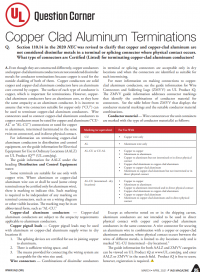jar546
CBO
In the early 1950s, copper shortages led cable manufacturers to develop an alternative conductor made from electrical-grade 1350 aluminum. By the 1960s, aluminum building wire had become popular across the United States. However, by 1968, it was identified as a hazard due to thermal instability and galvanic corrosion when connected to older wiring devices.
As a result of these problems, a massive product recall was issued, marking a significant event in the electrical industry. Shortly after, CCA emerged as a solution and was tested for performance by Underwriters Laboratories in the late 1960s. In 1971, it was included as one of only three conductors permitted by the National Electric Code.
CCA gained widespread use in the following decade due to high copper prices. However, its popularity dwindled after the Vietnam War ended, and copper prices decreased due to diminished demand from the military. With its high manufacturing and material costs, CCA could not compete with commodity-copper conductors.
Copper prices remained low until around 2005, allowing CCA to re-emerge as a viable alternative. Today, CCA is gaining popularity again as an affordable solution for building wire.
As a result of these problems, a massive product recall was issued, marking a significant event in the electrical industry. Shortly after, CCA emerged as a solution and was tested for performance by Underwriters Laboratories in the late 1960s. In 1971, it was included as one of only three conductors permitted by the National Electric Code.
CCA gained widespread use in the following decade due to high copper prices. However, its popularity dwindled after the Vietnam War ended, and copper prices decreased due to diminished demand from the military. With its high manufacturing and material costs, CCA could not compete with commodity-copper conductors.
Copper prices remained low until around 2005, allowing CCA to re-emerge as a viable alternative. Today, CCA is gaining popularity again as an affordable solution for building wire.



